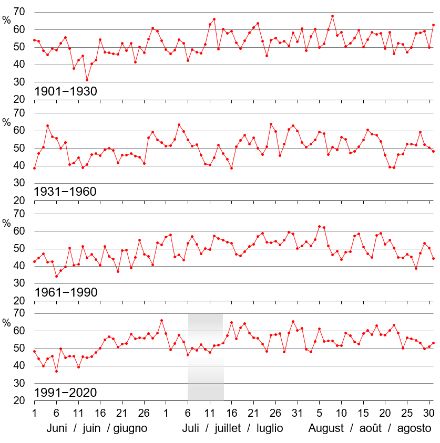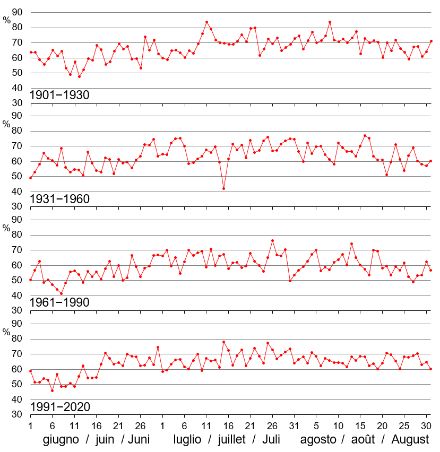Service Navigation
Search
Relative sunshine duration is the measure used to express how sunny a day is. For the calculation, the actual hours of sunshine recorded are compared to the absolute possible hours of sunshine for the day in question, from sunrise to sunset. So, if the sun shines for only half the possible time in the day because of cloud cover, the relative sunshine duration is 50 percent.
July is somewhat sun-deprived
During the climate normal period of 1991–2020, the relative sunshine duration trend for the Swiss plateau displays consistently low values for 6th to 14th July (Fig. 1, bottom curve). This segment of July was clearly less sun-kissed than the rest of the month.

South side of the Alps not affected
The drop in relative sunshine duration at the beginning of July is not seen on the south side of the Alps (Fig. 2, bottom curve). From the second half of June, the Lugano weather station shows a constant relative sunshine duration of between 60 and 70 percent. Little wonder, then, that Ticino is known as Switzerland’s sun parlour.

No long-term climate signal
In earlier normal periods before 1991–2020, there is no discernible pattern showing a drop in relative sunshine duration at the beginning of July, either for the Swiss plateau, the north side of the Alps (Fig. 1), or the south side of the Alps (Fig. 2). We can conclude from this that chance, i.e. the selection of the analysis period, plays a significant role in the determination of a regularly occurring weather singularity. In other words, something that might feature very prominently in one normal period may no longer be apparent in the next period.
An object lesson for country lore
A parallel can be drawn here with country lore, which describes typical weather patterns at certain times of the year, based on historical experience. Because of the variability and changes in the climate, however, what may have been true in a previous era may not be applicable to today’s weather. Country lore can therefore become completely invalidated as time goes on.